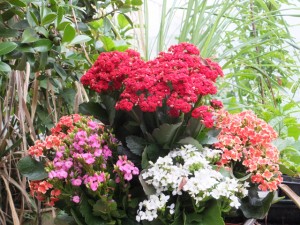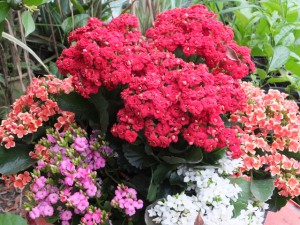Sounds like a sneeze, but very pretty, Kalanchoe
 Kalanchoes are tender greenhouse succulents with masses of brilliantly coloured small flowers that last many weeks in bloom. Most species come from West Africa, Asia and Madagascar, though the name is apparently of Chinese origin. Anyway Kalanchoes have also been called Bryophyllums, Kitchingias, Crassulas and Vereas.
Kalanchoes are tender greenhouse succulents with masses of brilliantly coloured small flowers that last many weeks in bloom. Most species come from West Africa, Asia and Madagascar, though the name is apparently of Chinese origin. Anyway Kalanchoes have also been called Bryophyllums, Kitchingias, Crassulas and Vereas.
One species, K. pinnata, has been called Miracle Leaf, Life Plant, Air Plant, Good-luck Leaf and other like names. This for the way a seemingly ‘dead’ leaf produces tiny plantlets along the edges as if by magic, even if the leaf is just hung by a thread in a window. This habit has made this a weed in New Zealand, Natal and Madeira. More prolific still, indeed showering plantlets, is a once common and otherwise rather boring houseplant K. daigremontiana.
But enough of these oddities; by far the best known, most decorative, indeed dazzingly flamboyant are the K. blosssfeldiana derivatives. There’s been bred a whole range of these widely available in florists and garden centres in late autumn and winter when their bright reds, vivid oranges, clean pinks and sharp whites are most appreciated. The flat fleshy leaves are deep green and an attractive foliage display.
 The visual impact of Kalanchoes is stunning and they deserve a place in full view, as long as it is also in full sun for they need light. Because of this they survive as houseplants on a sunny windowsill but flower much more profusely given full light in a bright greenhouse. Oddly most dwarf varieties close their flowers at night while the taller sorts remain open.
The visual impact of Kalanchoes is stunning and they deserve a place in full view, as long as it is also in full sun for they need light. Because of this they survive as houseplants on a sunny windowsill but flower much more profusely given full light in a bright greenhouse. Oddly most dwarf varieties close their flowers at night while the taller sorts remain open.
Kalanchoes are strongly day-length dependent and
with artificial light control can be brought into bloom any time of year. (They will flower after four weeks of fourteen hour nights.)
Kalanchoes are traditionally bloomed just once then discarded and replaced by new. True this does give better displays but to still perform quite well. (If you don’t intend to discard your plants then dead head immediately after flowering and pot up a size.)
New plants can be grown from seed but do not always come true. Kalanchoes are more easily multiplied by leaf or stem cuttings and of choice varieties. Cuttings are easy with a little bottom heat. As with most succulents let cuttings dry for a day or so before setting them to prevent the cut ends rotting. They should root very quickly.
Kalanchoes are content in most potting composts preferring sandy loam-based ones, well open and gritty. They do not like waterlogged soil so never place their pots in saucers. Of course like most succulents they need little water during autumn and winter even when in bloom. However in late spring and summer they can be given more, indeed more than most succulents, and then also appreciate regular dilute feeds.
Collectors will find the first species mentioned above worth looking for, though their flowers are less impressive their ‘odd’ habits and architectural structures makes them interesting. For the heated greenhouse there are many other attractive and curious perennial Kalanchoes. Some upright almost shrubby and others more lax. K. porphyrocalyx is a very pretty trailer with inflated rosy pink tubular flowers, it prefers a peat-like compost and is a choice subject for a hanging basket.


